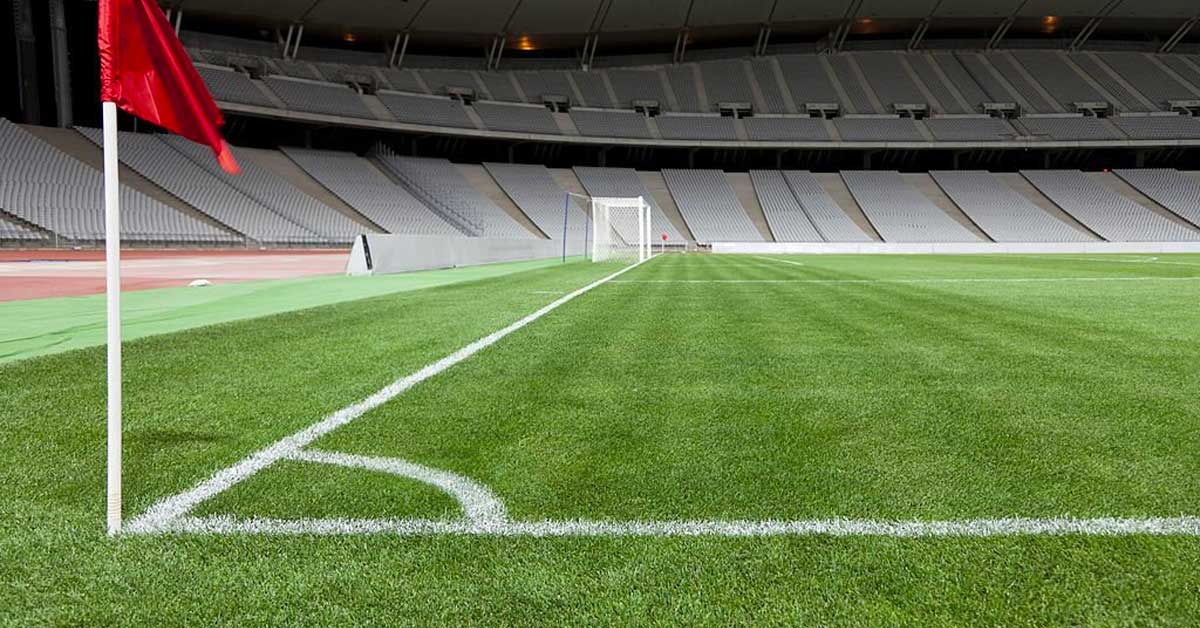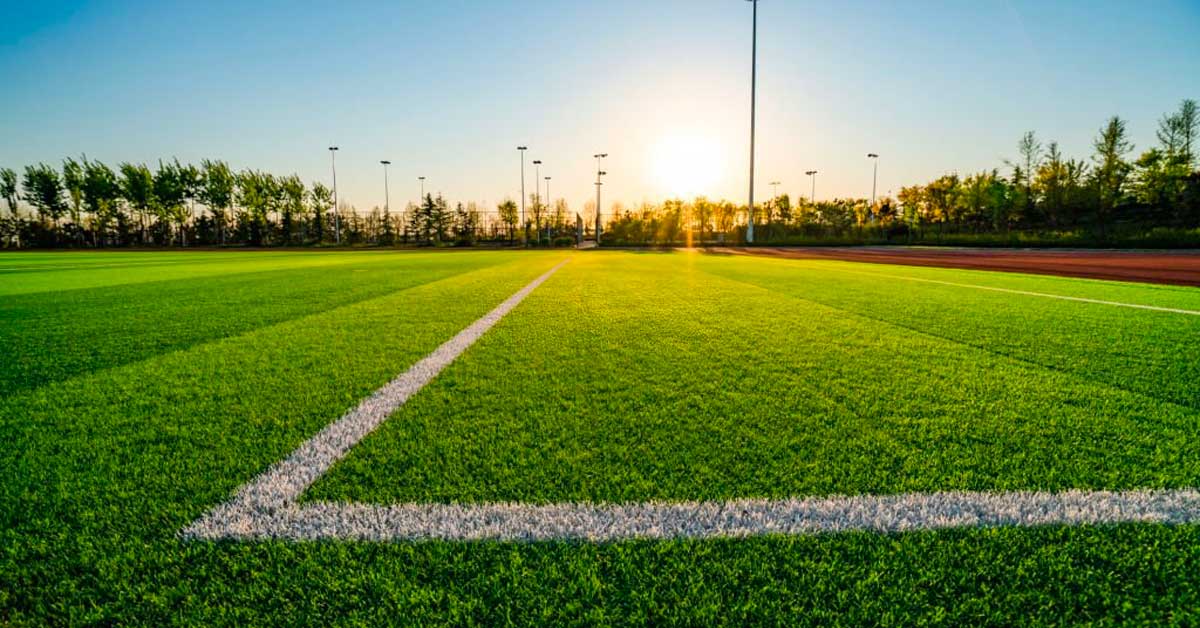Football pitches are often sprinkled or watered for several reasons:
Improved playing conditions: Sprinkling the football pitch helps to keep the grass healthy and maintain optimal playing conditions. Watering prevents the grass from drying out, becoming too hard, or developing uneven patches. It helps to maintain a consistent and level playing surface, which is crucial for fair play and player safety.
Cooling the surface: During hot weather or in areas with high temperatures, watering the pitch helps to cool down the surface. This is especially important for players’ comfort and safety, as excessive heat can lead to heatstroke or dehydration.
Dust suppression: Sprinkling the pitch helps to reduce dust, especially on dry and dusty pitches. Dust can affect players’ visibility, cause respiratory discomfort, and affect the ball’s movement. Watering helps to settle the dust and create a more favorable playing environment.
Impact absorption: A well-watered pitch provides better shock absorption and reduces the risk of injuries. The water acts as a cushioning layer between the players’ feet and the ground, reducing the impact on joints and muscles.
Maintenance of grass health: Regular watering supports the overall health of the grass. It promotes root growth, prevents wilting, and encourages a lush and green playing surface. Adequate hydration contributes to the longevity and quality of the turf.
Aid in ball movement: Wetting the pitch slightly can affect the ball’s movement. It can make the surface faster or slower, depending on the level of moisture. Some teams or players may prefer specific playing conditions, and sprinkling can help achieve the desired ball behavior.
It’s important to note that the amount and frequency of watering may vary based on factors such as climate, local conditions, and the type of pitch. The groundskeepers and maintenance staff typically monitor the pitch’s moisture levels and adjust watering accordingly to ensure optimal playing conditions.
How much does a football field sprinkler system cost?
The cost of a football field sprinkler system can vary widely depending on various factors such as the size of the field, the type of system, the level of automation, and regional variations in labor and material costs. It’s challenging to provide an exact figure without specific details, but I can give you a general idea of the potential costs involved.
For a standard-sized football field, the cost of installing a sprinkler system can range from several thousand dollars to tens of thousands of dollars. This estimate includes the cost of equipment, materials, labor, and any necessary permits or inspections.
Factors that can influence the cost include:
- System type: There are various types of sprinkler systems available, such as fixed spray systems, rotor systems, or drip irrigation systems. The type of system you choose will affect the overall cost.
- Coverage area: The size of the football field will impact the cost. Larger fields will require more sprinkler heads, piping, and irrigation zones, which can increase the installation cost.
- Automation and control: The level of automation and control features you desire will affect the cost. Advanced systems with computerized controllers, weather sensors, and remote access capabilities tend to be more expensive than basic manual systems.
- Site preparation: If the field requires significant site preparation, such as grading, trenching, or electrical work, it can add to the overall cost.
- Regional factors: Labor and material costs can vary depending on your location. Prices may differ based on local market conditions, availability of contractors, and regional regulations.
To obtain an accurate cost estimate, it is recommended to consult with irrigation professionals or contractors who specialize in sports field installations. They can assess your specific requirements, evaluate the site, and provide you with a detailed estimate based on your needs.

What kind of grass is planted on football fields?
Several types of grass are commonly planted on football fields, depending on factors such as climate, field usage, and maintenance practices. Here are a few popular grass species used on football fields:
- Kentucky Bluegrass: Kentucky Bluegrass is a cool-season grass that is commonly used on football fields in northern regions or areas with cooler climates. It has good wear tolerance and recovery capabilities, making it suitable for high-traffic areas. Kentucky Bluegrass forms a dense and attractive turf.
- Perennial Ryegrass: Perennial Ryegrass is another cool-season grass that is often used on football fields. It has excellent wear tolerance, rapid establishment, and a fine texture. Perennial Ryegrass provides good turf density and can handle heavy use.
- Bermuda Grass: Bermuda Grass is a warm-season grass that thrives in hot and sunny climates. It is commonly used on football fields in southern regions. Bermuda Grass has excellent wear tolerance, good recovery, and a dense growth habit. It can handle high temperatures and requires less water than cool-season grasses.
- Zoysia Grass: Zoysia Grass is another warm-season grass that is sometimes used on football fields, particularly in areas with a moderate climate. It forms a dense turf with good wear tolerance and recovery. Zoysia Grass requires less maintenance than some other grass species.
- Tall Fescue: Tall Fescue is a cool-season grass that is occasionally used on football fields, particularly in areas with harsher climates or in areas where water availability is limited. It has good wear tolerance and is known for its deep root system and drought resistance.
It’s important to note that there is no one-size-fits-all grass species for football fields. The choice of grass depends on various factors, including the climate of the region, intended usage, maintenance resources, and budget considerations. Sports field managers and turfgrass professionals typically select the most appropriate grass species based on these factors to ensure a durable and aesthetically pleasing playing surface.
Is it real grass on football pitches?
Yes, it is common for football pitches to have real grass surfaces. Natural grass provides several advantages for football play, including good ball roll, traction, and impact absorption. Real grass can also contribute to a more aesthetically pleasing and traditional playing environment.
However, it’s worth noting that some football pitches, particularly those in indoor stadiums or regions with extreme climates, may use artificial turf or hybrid systems that combine natural grass with synthetic fibers. These synthetic surfaces are designed to mimic the characteristics of natural grass while offering increased durability and resilience to heavy use and adverse weather conditions.
The choice between natural grass and artificial turf often depends on factors such as the stadium’s location, climate, maintenance resources, frequency of play, and budget considerations. Both natural grass and artificial turf have their advantages and considerations, and the decision ultimately rests on the preferences and specific needs of the stadium or facility management.

